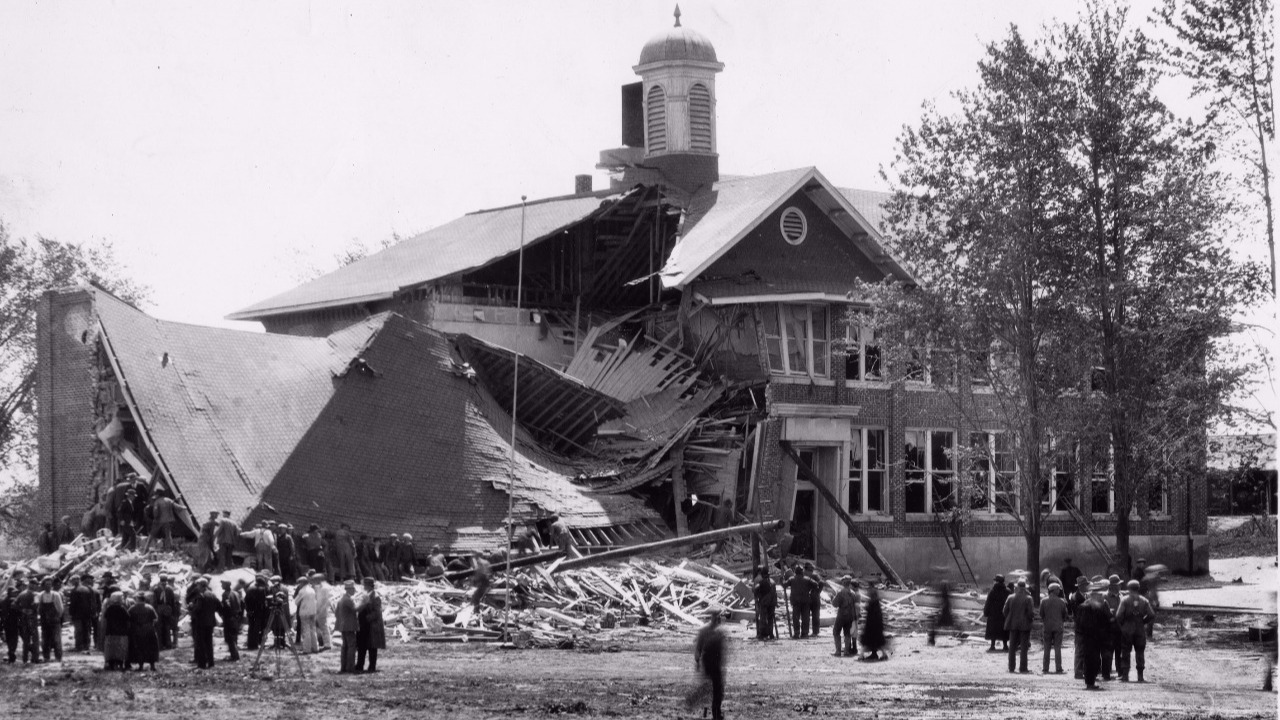America's Deadliest School Attack: The Bath School Disaster of 1927

On May 18th, 1927, the children of Bath Consolidated School were settling into their morning lessons when the world exploded around them. Thirty-eight kids would never make it home. The man responsible? Their own school board treasurer, who had been planning this attack for months right under everyone's noses.
The Bath School Disaster: When Revenge Became Murder
The Making of a Monster
Andrew Philip Kehoe was born into chaos. February 1st, 1872, in Tecumseh, Michigan, as one of thirteen children fighting for attention in a household that probably felt more like survival of the fittest than family dinner. When you're competing with twelve siblings for everything from food to affection, you learn to fight dirty early.
Andrew found his escape through education, clawing his way into electrical engineering at Michigan State College. He was smart, determined, and hungry for something better than farm life. After graduation, he headed to St. Louis, where he built himself a respectable career as an electrician. Life was looking up for Andrew Kehoe.
Then everything changed.
During a fall, Andrew suffered a severe head injury that left him unconscious for several weeks. When he finally woke up, his family noticed something different. The stubborn streak that had always been part of Andrew's personality had transformed into something more volatile. His temper was shorter, his irritability more pronounced. Most devastatingly for someone who prized his independence above everything else, he was forced to move back to his father's farm to recover.
A Stepmother's Mysterious Death
The farm was no longer the place Andrew had left behind. After his mother's death, his father Philip had married Frances Wilder, a much younger widow. Frances was only three years older than Andrew himself, making their relationship awkward from the start. Here was this woman, barely out of her twenties, now playing stepmother to a man who was almost her peer.
Andrew despised the arrangement. Here he was, a grown man with a college degree, reduced to living under the authority of his father's young wife. The resentment festered.
One day, while cooking in the kitchen, Frances bent down to light the oil stove when it suddenly exploded. The flames caught her arm and chest, creating a dangerous but not necessarily fatal situation. That's when Andrew rushed in to help.
What happened next would haunt the family forever. Andrew threw a bucket of water over the burning woman - a reaction that seems logical until you understand the physics of oil fires. Water doesn't extinguish oil flames; it spreads them. The bucket of water Andrew threw caused the fire to engulf Frances's entire body. She died the following day from her injuries.
Was it panic that made Andrew grab water instead of dirt or a blanket to smother the flames? Or was it something more calculated? The family never got answers, but Andrew certainly benefited from the tragedy. With Frances gone, he no longer had to share his father's attention or inheritance with a stepmother and potential half-siblings.
Building a Reputation
Andrew eventually married Ellen "Nellie" Price, the daughter of a wealthy Lansing family he'd met during college. Around 1911, when he was nearly forty, they moved to a farm outside Bath Township. This should have been Andrew's fresh start, but old patterns die hard.
The community quickly learned what kind of neighbor they'd inherited. Andrew was notorious for his explosive temper and his absolute unwillingness to back down from any disagreement. He shot and killed a neighbor's dog for wandering onto his property and barking. He bragged about beating one of his own horses to death when it didn't perform to his standards. These weren't heat-of-the-moment reactions - they were deliberate acts of violence that Andrew seemed to take pride in.
But there was one trait that actually worked in Andrew's favor: he was obsessively frugal. When the Bath Consolidated School Board needed a new treasurer, they saw Andrew's penny-pinching nature as exactly what they needed. Here was a man who would scrutinize every expense and ensure the school never spent beyond its means.
The irony wasn't lost on anyone that Andrew was also the community's most vocal advocate for lowering taxes and cutting school funding. He argued passionately at every opportunity that the community was spending too much on education. What the school board didn't realize was that Andrew's opposition wasn't philosophical - it was personal.
When the Bills Come Due
Andrew was struggling financially, barely keeping his farm afloat when the county raised local taxes to help fund the new Bath Consolidated School. The increase wasn't massive, but for someone already living on the edge, it was the difference between making his mortgage payment and losing everything.
The farm wasn't even technically his. Nellie's uncle owned the property and held the mortgage. When foreclosure papers arrived, Andrew was livid. He reportedly told the sheriff serving the papers: "If it hadn't been for that 300 dollar school tax I might have paid off this mortgage."
In Andrew's mind, the school had stolen his farm. The community that had entrusted him to manage their children's education budget had destroyed his financial future. The betrayal cut deep.
There was a glimmer of hope when the county appointed Andrew as temporary town clerk, a position that came with a decent salary and the possibility of permanent employment if he won the upcoming election. This could have been Andrew's salvation.
But Andrew's reputation preceded him. The community that knew about the dead dog and the beaten horse decided they didn't want this man representing them in an official capacity. Andrew was defeated in the election, and he took it as confirmation that everyone was against him.
The Descent Into Darkness
The signs were there for anyone paying attention. After losing the election, Andrew's behavior became increasingly erratic. His wife Nellie was chronically ill, likely with tuberculosis, requiring expensive hospital stays they couldn't afford. The medical bills were another financial burden on a man already pushed to his breaking point.
Neighbors watched Andrew's property slowly deteriorate. He removed all the fencing. He cut down mature trees and severed grapevines, destroying years of agricultural investment. Most disturbing, residents began hearing explosions coming from the Kehoe farm throughout the summer of 1926. Andrew would later tell people he was removing tree stumps with dynamite, but that explanation didn't account for the frequency or intensity of the blasts.
What Andrew was really doing was practicing. He was learning how to build bombs, experimenting with different types of explosives, perfecting his technique. All while serving as the treasurer for the very school he was planning to destroy.
The Plan Takes Shape
For months, Andrew had been placing dynamite and pyrotol, a World War I explosive, under the flooring of Bath Consolidated School. As treasurer, he had access to the building whenever he wanted. He could work on wiring and placement during evenings and weekends without arousing suspicion. After all, he was known for his attention to detail when it came to school business.
Andrew had rigged both wings of the school building with hundreds of pounds of explosives. His plan was comprehensive: destroy the entire building during school hours, maximizing casualties. This wasn't a crime of passion - it was methodical, calculated revenge.
In May 1927, with foreclosure looming and Nellie home from the hospital, Andrew put his plan into motion. First, he murdered his wife, likely by bludgeoning her to death, then placed her body in a wheelbarrow and moved it to the chicken coop. He set timed incendiary devices throughout his farm buildings, ensuring that all his property would burn.
May 18th, 1927: The Day Everything Exploded
Classes at Bath Consolidated School started at 8:30 AM on May 18th, 1927. At 9:45 AM, with 236 students aged six to eighteen sitting at their desks, Andrew's carefully planted explosives detonated.
A teacher who survived the blast described the horrifying scene: "the air seemed to be full of children and flying desks and books. Children were tossed high in the air, some were catapulted out of the building."
The explosion killed 38 children and 6 adults instantly. But Andrew wasn't finished.
As the community rushed to help rescue survivors from the rubble, Andrew pulled up to the school in his truck, loaded with even more explosives and metal debris intended as shrapnel. School principal Emory Huyck, sensing something was wrong, ran toward Andrew's vehicle and tried to wrestle a rifle away from him.
That's when Andrew detonated his truck bomb, killing himself, Principal Huyck, and several others who had come to help the injured children. The secondary explosion sent hundreds of pounds of metal flying into the crowd of rescuers and survivors.
The Aftermath: A Community's Response
In total, 45 people died in Andrew Kehoe's attack, with another 58 injured. It remains the deadliest school attack in American history.
But here's what makes this story remarkable: the community refused to let Andrew's hatred define them. While rescue workers searched through the rubble for survivors, they discovered something that could have made the tragedy even worse. Another 230 kilograms of dynamite were found unexploded under the south wing of the school. Had all of Andrew's bombs detonated as planned, the death toll would have been catastrophic.
The people of Bath Township didn't retreat into fear. They raised funds to rebuild their school. While construction was underway, they moved classes to the community hall, town hall, and local retail buildings. Most of the surviving students returned to continue their education, refusing to let one man's revenge destroy their children's futures.
Understanding the Unthinkable
Andrew Kehoe's attack wasn't the result of sudden mental breakdown - it was the culmination of years of grievance, entitlement, and unchecked rage. He believed the world owed him success, and when life didn't deliver, he decided everyone else should pay the price.
The Bath School disaster forced America to confront uncomfortable questions about school safety and community trust that we're still grappling with today. How do you protect children from someone who has legitimate access to their environment? How do you identify when someone's grievances are transforming into something dangerous?
Andrew Kehoe spent months planning his attack while continuing to serve in a position of trust within the community. He was their treasurer, responsible for managing the finances of the institution he was secretly planning to destroy. The betrayal cut as deep as the violence itself.
But perhaps the most important lesson from Bath Township is what happened after the explosions. A community chose resilience over fear, rebuilding over retreat. They refused to let Andrew Kehoe's final act of hatred become their defining story.
Nearly a century later, Bath Consolidated School stands rebuilt, filled with new generations of students. Andrew Kehoe succeeded in taking 45 lives, but he failed in his larger goal of destroying a community's spirit. In the end, that might be the most important victory of all.






